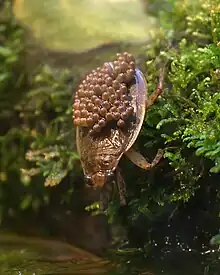| Abedus herberti | |
|---|---|
 | |
| Male with eggs on his back at the Cincinnati Zoo | |
| Scientific classification | |
| Domain: | Eukaryota |
| Kingdom: | Animalia |
| Phylum: | Arthropoda |
| Class: | Insecta |
| Order: | Hemiptera |
| Suborder: | Heteroptera |
| Family: | Belostomatidae |
| Genus: | Abedus |
| Species: | A. herberti |
| Binomial name | |
| Abedus herberti Hidalgo, 1935 | |
Abedus herberti, the toe biter (a name also used for several other giant water bugs) or ferocious water bug, is a species of giant water bug in the family Belostomatidae.[1][2] It is native to streams, especially in highlands, in Arizona, New Mexico and Utah in the United States and in northwestern Mexico.[3][4] Adults are typically 2 to 4 cm (0.8–1.6 in) long.[3][5] The species is flightless, but may move overland between water sources.[3] It will bite in self-defense, which is painful but not dangerous.[3]
A. herberti is often displayed in zoos, sometimes together with the sunburst diving beetle.[6] These two species also occur together in the wild.[7]
Behavior

As in its relatives, A. herberti has an unusual breeding behavior where the female attaches the eggs to the male's back and he takes care of them until they hatch into nymphs.[3] Each egg can measure as much as 6 mm × 2 mm (0.24 in × 0.08 in) when fully developed, making them some of the largest insect eggs.[5] After hatching from the eggs, the nymphs go through five instar stages before adulthood.[8]
A. herberti is a sit-and-wait predator that catches small animals, especially invertebrates such as other aquatic insects and snails, but also small vertebrates such as young fish and tadpoles.[7] Small and medium-sized prey items are caught with their strong front legs and stabbed with the proboscis, which injects a saliva that both incapacitates the prey and dissolves it.[7] The largest food category (animals 1.2 cm [0.5 in] or more in length) are mostly scavenged. The only prey they regularly catch alive (not just scavenge) in the largest category is nymphs of their own species.[7] Adults are generally highly cannibalistic towards their nymphs and older nymphs often eat younger; adults however only rarely cannibalize other adults.[7][8]
Subspecies
These two subspecies belong to the species Abedus herberti:
- Abedus herberti herberti Hidalgo, 1935
- Abedus herberti utahensis Menke, 1960
References
- ↑ "Abedus herberti Report". Integrated Taxonomic Information System. Retrieved 2019-09-23.
- ↑ "Abedus herberti". GBIF. Retrieved 2019-09-23.
- 1 2 3 4 5 "Abedus herberti species Information". BugGuide.net. Retrieved 2019-09-23.
- ↑ M.T. Bogan; O.G. Gutiérrez-Ruacho; J.A. Alvarado-Castro; D.A. Lytle (2013). "New Records of Martarega, Graptocorixa, and Abedus (Heteroptera: Notonectidae, Corixidae, Belostomatidae) From Northwestern Mexico and Arizona, Including the First Record of Graptocorixa emburyi In the United States". The Southwestern Naturalist. 58 (4): 494–497. doi:10.1894/0038-4909-58.4.494.
- 1 2 R.L. Smith; C. Horton (1998). "Fish predation on giant water bug (Heteroptera: Belostomatidae) eggs in an Arizona stream". Great Basin Naturalist. 58 (3): 292–293.
- ↑ O’Sullivan, T. "Captive rearing study of the Thermonectus marmoratus" (PDF). St. Louis Zoo. Retrieved 9 April 2018.
- 1 2 3 4 5 J. Velasco; V.H. Millan (1998). "Feeding Habits of Two Large Insects from a Desert Stream: Abedus herberti (Hemiptera: Belostomatidae) and Thermonectus marmoratus (Coleoptera: Dytiscidae)". Aquatic Insects. 20 (2): 85–96. doi:10.1076/aqin.20.2.85.4500.
- 1 2 R.L. Smith (1974). "Life History of Abedus herberti in Central Arizona (Hemiptera: Belostomatidae)". Psyche: A Journal of Entomology. 89 (2): 272–283. doi:10.1155/1974/83959.
External links
 Media related to Abedus herberti at Wikimedia Commons
Media related to Abedus herberti at Wikimedia Commons